Are you a Quiet Speculation member?
If not, now is a perfect time to join up! Our powerful tools, breaking-news analysis, and exclusive Discord channel will make sure you stay up to date and ahead of the curve.
Four weeks after proposing a UR Delver shell with Ptermanader, I've got some insights to share. And I also have more than a few words on Wizards' newly-proposed mulligan rule, which has considerable implications for Modern—and for Colorless Eldrazi Stompy.
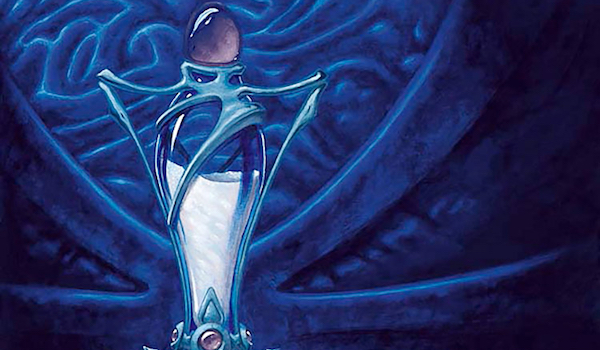
'Manders
As soon as "Salamander Drake" was spoiled, I set to work on UR Delver, building a thresh shell from scratch around the innocuous blue Tombstalker. Some days after my article went live, Pteramander's English name was revealed; some weeks later, the card's strength in UR Phoenix was revealed. But I don't think UR Delver is necessarily a worse Phoenix deck. Its two big strengths over the format boogeyman are its resilience to hate and the ability to pack heavy-duty disruption itself. It gains these edges, of course, at the cost of precious proactivity: never will UR Delver find itself attacking for 6 on turn two.
UR Delver, by Jordan Boisvert
Deck Changes
Over the past month, I've made some tweaks to the initial shell.
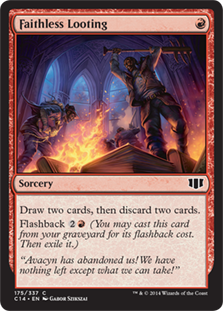 Enablers: 4 Opt replaced by 2 Chart a Course and 2 Faithless Looting. The new cards are simply better at enabling Pteramander. Chart "tucks" a second spell for a next-turn adapt or simply allows us to profit from 1/1 Salamanders. Having additional CMC 2 cards for Shoal is also nice.
Enablers: 4 Opt replaced by 2 Chart a Course and 2 Faithless Looting. The new cards are simply better at enabling Pteramander. Chart "tucks" a second spell for a next-turn adapt or simply allows us to profit from 1/1 Salamanders. Having additional CMC 2 cards for Shoal is also nice.
Meanwhile, Looting joins Scour in gassing up the graveyard. With multiple Pteramanders in play, it's often advantageous to aggressively loot away instants and sorceries and make big attacks. But without them, Looting sifts past lands in longer games and finds the action.
Doodads: Mountain and Abrade replaced by Island and Spite of Mogis. Mountain was mostly just worthwhile when UW opponents tried to cut me off red. The rest of the time, it proved a liability, gumming up opening hands and sitting around just not casting anything most of the time.
Abrade wasn't providing enough utility for me game 1, while a problem I continuously encountered was running into big creatures. I played Flame Slash for a bit to deal with Thing in the Ice and Crackling Drake. But Looting turns on Spite practically as fast, and Spite can also kill larger creatures, namely Tarmogoyf. I was worried at first about graveyard hate, but the only creature deck likely to bring in Rest in Peace is Spirits, and I already love that matchup. Besides, Looting lets us bin dead Spites or whatever else.
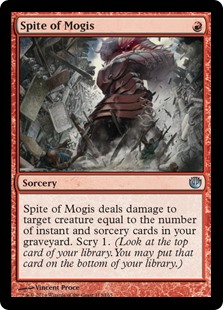 Sideboard: 2 Anger of the Gods and 1 Crackling Drake replaced by Spite of Mogis, Spell Pierce, and a third Abrade. Ah, here's that third Abrade! I hold that the Crackling plan is awesome in this deck, but 4 in the 75 were just too many. I'd sometimes clog on them while setting up a gameplan and have been happy on 3. At first I tried another Vendilion Clique in the extra spot, but ended up settling on Spell Pierce, a card I want as many of as possible in many matchups. This Spite was also Slash at first.
Sideboard: 2 Anger of the Gods and 1 Crackling Drake replaced by Spite of Mogis, Spell Pierce, and a third Abrade. Ah, here's that third Abrade! I hold that the Crackling plan is awesome in this deck, but 4 in the 75 were just too many. I'd sometimes clog on them while setting up a gameplan and have been happy on 3. At first I tried another Vendilion Clique in the extra spot, but ended up settling on Spell Pierce, a card I want as many of as possible in many matchups. This Spite was also Slash at first.
Place in the Metagame
These weeks of testing and playing have granted me a better understanding of UR Delver's roles and potential niches in Modern.
Compared with Phoenix, it finds the interactive matchups quite breezy; no need to worry about Surgical Extraction or Damping Sphere putting a damper on its day. The post-board Crackling Drake package combines with 4 Snapcaster Mage and the inevitability of Ptermander itself to dominate opponents looking for two-for-ones. It also doesn't hurt that Modern's most played two-for-one cards are planeswalkers such as Teferi, Hero of Dominaria and Liliana of the Veil, or steep-costed instants like Hieroglyphic Illumination, Kolaghan's Command, and Cryptic Command—Spell Pierce has a field day with these would-be haymakers, not to mention Snap-Spell Pierce!
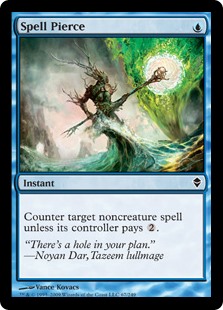 Where UR Delver falters on paper, then, is against the less interactive decks. Some of those matchups actually improve—basically, the ones that lose to Spell Pierce: Ad Nauseam, Storm, and the resurgent Ironworks deck. These decks are even easier for UR Delver to beat than for Phoenix.
Where UR Delver falters on paper, then, is against the less interactive decks. Some of those matchups actually improve—basically, the ones that lose to Spell Pierce: Ad Nauseam, Storm, and the resurgent Ironworks deck. These decks are even easier for UR Delver to beat than for Phoenix.
Not so against Burn, where Phoenix has a clear edge. A first-turn 3/2 with flying just isn't so fast anymore, and if our lock pieces and Pierces don't pull a lot of weight in a given matchup, we find ourselves in a slog. It turns out Spell Pierce and Disrupting Shoal are mostly good against Searing Blaze decks when we've also got a Tarmogoyf or two in play. Creature-based aggressive decks are easier on UR Delver thanks to Snapcaster and our many removal spells.
Mulls
In two months, the Mythic Championship II in London will make guinea pigs of Modern players eager to test the London Mulligan. That rule reads as follows:
When you mulligan for the Nth time, you draw seven cards, then put N cards on the bottom of your library in any order.
 On its face, this rule is designed to smooth out openers even more than "scry 1," letting more players play more satisfying games of Magic. In Modern, it also plays to the idea of diversity. We've seen decks enter the format after receiving a critical redundant piece from a newly-released set: Cheeri0s getting Sram, Senior Artificer, for instance, or Goryo's As Foretold snagging Electrodominance. If mulligans improve at finding the right cards, perhaps more lurking strategies can surface without first being graced by a redundancy booster.
On its face, this rule is designed to smooth out openers even more than "scry 1," letting more players play more satisfying games of Magic. In Modern, it also plays to the idea of diversity. We've seen decks enter the format after receiving a critical redundant piece from a newly-released set: Cheeri0s getting Sram, Senior Artificer, for instance, or Goryo's As Foretold snagging Electrodominance. If mulligans improve at finding the right cards, perhaps more lurking strategies can surface without first being graced by a redundancy booster.
Of course, there's one exception to this notion: diversity decreases if some decks prove too consistent with the new rule. Should Wizards end up pleased with the London Mulligan anyway, there's always the banlist to address over-performing archetypes directly. But the last time Wizards considered this mulligan (in a marginally different iteration called "7-7-7"), they indeed deemed it unacceptably powerful:
This mulligan was way too strong in Constructed, and encouraged big changes in deck building. Perhaps the most notable thing was in Modern and Eternal formats, where sideboard hate got a lot stronger since you could shuffle extra copies back into your decks. Similarly, combo decks got a huge advantage since they could mulligan away possibly useless cards. In one of our biggest rules violations for changing the mulligan rule, it clearly changed the parameters for deck building, and would have a profound impact on how older formats played out.
Another issue I haven't heard much about is one of time. London Mulligans may take extra long as less-experienced players deliberate about which cards to put back before ultimately deciding, during the next step of the process, to ship their hand anyway.
I think the company very much likes this new rule, but is also wary of its potential in Modern. Mythic Championship II is then the litmus test to see just how much such a rule would alter deckbuilding and the incentive to mulligan in an already mulligan-centric format.
Strategic Effects
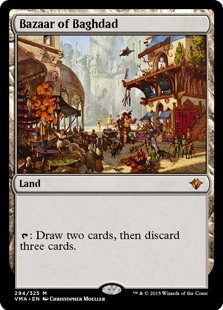 Decks become more consistent. What does that mean in practice? Combo-centric decks, or decks focused around a single card, stand to gain the most from the London Mulligan. On the other hand, opponents now have an easier time locating hate cards.
Decks become more consistent. What does that mean in practice? Combo-centric decks, or decks focused around a single card, stand to gain the most from the London Mulligan. On the other hand, opponents now have an easier time locating hate cards.
For an extremely obvious example, take Vintage Dredge, which runs 4 Serum Powder to increase the odds of opening Bazaar of Baghdad. That deck is now much better at opening Bazaar, but its opponents are also better at opening Leyline of the Void. A Modern example? Cheeri0s improves at finding a cantrip creature, but its opponents have more of a shot at opening Eidolon of the Great Revel or Chalice of the Void.
Essentially, the more combination- or card-dependent the deck, the better it becomes under the London Mulligan. And the more easily disrupted it is by played hosers, the worse it becomes under the London Mulligan. These numbers do not always correlate; some decks, like BG Rock and Burn, mulligan very little. The former is resilient enough to be mostly unaffected by the London (no net change), while the latter now has to worry about increased odds of opponents finding life-gaining silver bullets (negative net change). Alternatively, consider decks that mulligan heavily, such as Cheeri0s and Colorless Eldrazi Stompy. The former is soft to enemy hate (no net change), while the latter resists enemy hate (positive net change). Unsurprisingly, I'm mostly interested in the latter.
Eldrazi Calling
Colorless Eldrazi Stompy is the perfect deck to abuse the London Mulligan. It's built around finding Eldrazi Temple, just as Vintage Dredge is built around finding Bazaar. Key difference: there's no Leyline of the Void equivalent that shuts Eldrazi out of the game. Key similarity: Eldrazi's use of Serum Powder, which happens to become extra potent under the new rule.
Colourless Oi Guv'na Stompy, by Jordan Boisvert
Serum Powder presents an interesting design balanced by a couple restrictions. First, Powder decreases in power with each true mulligan taken—it starts exiling and drawing six cards, then five, then four. Second, an otherwise competent hand with Serum Powder was a functional mulligan on its own, as no constructed player is ever too happy to open a three-mana, no-draw Mind Stone. When I first saw the London Mulligan rule, I erroneously thought it would eliminate both of these drawbacks.
 My misunderstanding was that under the London, every Serum Powder exiled and drew seven cards. This change would significantly increase both the odds of drawing into more Eternal Scourges and Powders for mulling-ups, and the odds of finding Eldrazi Temple. Every Powder opened represented seven non-Temple cards gone from the deck for our next mulligan.
My misunderstanding was that under the London, every Serum Powder exiled and drew seven cards. This change would significantly increase both the odds of drawing into more Eternal Scourges and Powders for mulling-ups, and the odds of finding Eldrazi Temple. Every Powder opened represented seven non-Temple cards gone from the deck for our next mulligan.
In fact, the rule states that after each mulligan, cards are put back into the deck before a new mulligan decision is made. So Powder doesn't get the quite the boost I assumed. It's still made better: seeing extra cards lets us dig deeper into Powder and Scourge, setting up hands to exile away for additional "free" mulligans. Under the old system, a keep there would yield drawing into that copy of Powder a couple turns down the road.
Powder's second drawback is indeed eliminated, though. Copies of the artifact found in our good hand are simply tucked under the library, where they're unlikely to ever be heard from again—we don't shuffle our own deck, after all.
Since we're now likelier than ever to find Temple early, I've built this deck a little differently from previous builds. Endless One increases in stock, both because it's more often under-costed and because I anticipate fewer Pushes in a London Mulligan world (more streamlined decks=less interaction). Having Temple lets us play the aggressor more reliably, a gameplan One contributes more than Matter Reshaper or Smuggler's Copter. My love of Copter in this deck knows no bounds, but I've trimmed one since we no longer start the game with dead cards, ever (unless we find a keepable seven that includes Powder, which should win us the game regardless).
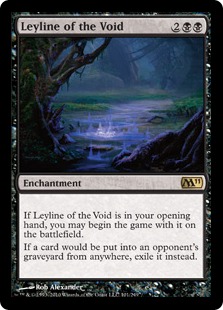 The sideboard also gets a makeover. Gone are the grindy Relic of Progenituses, which prevented opponents from ever out-carding our Eternal Scourges. We're just faster than that now. And Relic, while annoying, doesn't cripple graveyard strategies like Leyline of the Void, which becomes supremely findable between Powder and the London. Recently successful Colorless lists, like Austin Gattuo's 6th-place one from the SCG Glassboro IQ two weeks back, have already transitioned to Leyline; the London further incentivizes that choice: open two? Tuck one! My sideboard also includes a number of hoser bullets to mulligan for, matchup depending.
The sideboard also gets a makeover. Gone are the grindy Relic of Progenituses, which prevented opponents from ever out-carding our Eternal Scourges. We're just faster than that now. And Relic, while annoying, doesn't cripple graveyard strategies like Leyline of the Void, which becomes supremely findable between Powder and the London. Recently successful Colorless lists, like Austin Gattuo's 6th-place one from the SCG Glassboro IQ two weeks back, have already transitioned to Leyline; the London further incentivizes that choice: open two? Tuck one! My sideboard also includes a number of hoser bullets to mulligan for, matchup depending.
Colorless Eldrazi Stompy is already the best-performing Spaghetti Monster shell in the format, and has been for a couple months. I wonder if the London Mulligan could push it into the realm of Tier 1.
Piped Up in London
As I adapt Pteramander week after week, concerned Boston-area Modern players ask me what happened to Eldrazi. I'm just having more fun on Delver right now, I reply. Of course, I'd still favor Colorless for larger events. But if anything could make me bring it to everything, it might just be the London Mulligan. Which decks do you think will be most impacted by the rules change? Will Wizards go through with a switch at all? Is Mythic Championship II doomed to fall to Eternal Scourge? All this, and more... in the comments!




Thanks for your content.
I picked up the Stompy deck last fall as my first Modern deck and have been loving it. When I heard about the mulligan rule last night at my local shop for Modern I immediately thought this deck improves from it. I hadn’t thought about how it improves hosers or that Stompy is somewhat immune to hate. Your insight has helped my game and strategy once again.
My local meta has lots of Path and Trophy so I’ve added one more Wastes in lieu of a Scavenger Grounds and I’m experimenting with copy 5 of Seer and Smasher in the form of Phyrexian Metamorph. I’ve tried it in place of one Shaper or one Copter. What do you think?
Cheers!
I have never been a fan of Metamorph. We rarely want to copy enemy permanents since ours are so good, and that removes a lot of its utility. I think it’s mostly win-more since we need a nice target on the board already and generally prefer high-utility cards that do the same thing every time. Definitely think the last two Shapers and 2nd Copter are flex though and encourage customization in this slots, so whatever works for you!
According to Ian Duke on twitter (https://twitter.com/mtg_ianduke/status/1098767958141132800) this is the first time they’ve actually tested this mulligan rule. The 2015 statement that it was “too strong” seems to have been pure theorycrafting.
Good to know! The way Wizards describes 7-7-7 in the featured quote (using the past tense rather than the conditional “would be”) implies that it was tested, which is why I didn’t dig deeper for confirmation.
Eldrazi Stompy folds hard to Ensnaring Bridge. With your only out to a slow Ratchet Bomb.
It definitely does. I used to play Ratchets in large part because of Bridge, but have cut them for a few reasons:
– current Bridge decks protect it with Needle/Jar
– almost nobody is playing Bridge right now, making it supremely easy to dodge
– Contortion is better against existing aggro decks than Bomb
I still don’t understand how the London Mulligan rule works with Powder. Could you try to explain it in simpler terms?
Sure.
Open 7 with Powder: exile hand, take 7
—
Open 7 without Powder: put hand back, shuffle, draw 7, put one card back, THEN decide whether to Powder
If yes: exile hand, take 6
To mulligan this hand: shuffle it in, draw 7, put two back, THEN decide whether to Powder
etc.
The London, besides increasing the odds of hitting Temple through normal mulligans (which then scale up accordingly as we remove cards from the library with Powder), allows us to “set up” the hands we exile with Powder. In the example above, for instance, we can choose to bottom important cards like Dismember, TKS, or even lands before exiling our hand. Then there’s a chance of re-drawing those cards during future mulligans or if opponents make us shuffle
Have you played the UR delver shell against colorless Eldrazi stompy? How did it fair? Specifically, if your game one on the draw and they slam a chalice on 1, do you find it difficult to work out of?
I run into it online sometimes. It’s really rough Game 1 but manageable after siding. They struggle if we stick a flier. Abrade is important post-board. Clique and Crackling are MVP.
Thanks for the advice.